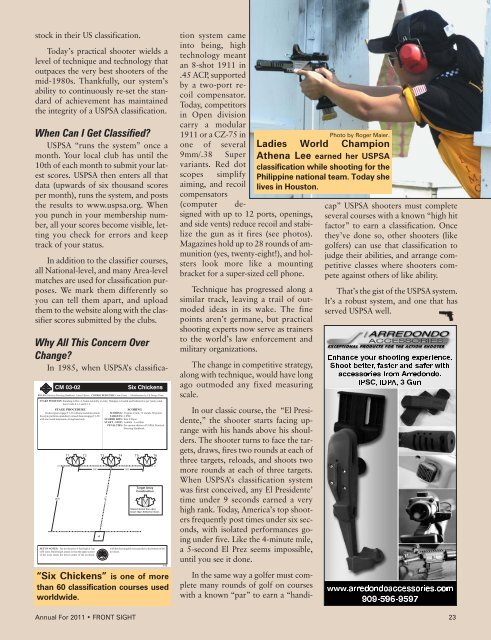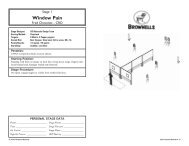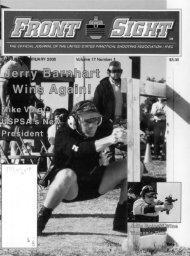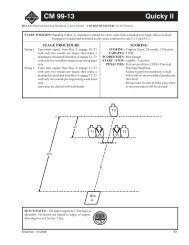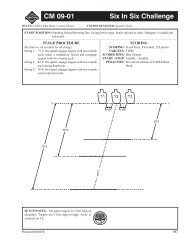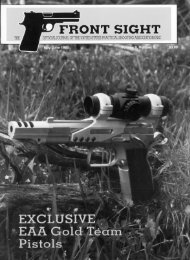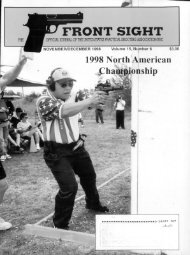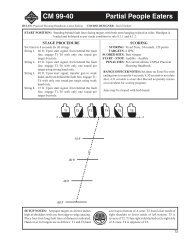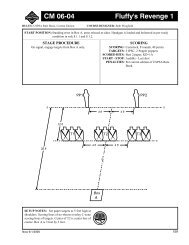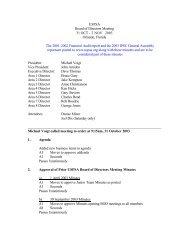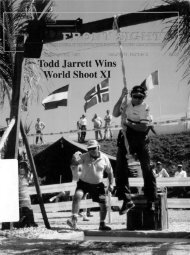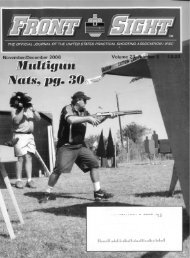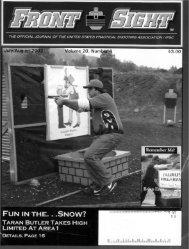Create successful ePaper yourself
Turn your PDF publications into a flip-book with our unique Google optimized e-Paper software.
A<br />
B<br />
D C A C D<br />
©<br />
stock in their US classification.<br />
Today’s practical shooter wields a<br />
level of technique and technology that<br />
outpaces the very best shooters of the<br />
mid-1980s. Thankfully, our system’s<br />
ability to continuously re-set the standard<br />
of achievement has maintained<br />
the integrity of a USPSA classification.<br />
When Can I Get Classified?<br />
USPSA “runs the system” once a<br />
month. Your local club has until the<br />
10th of each month to submit your latest<br />
scores. USPSA then enters all that<br />
data (upwards of six thousand scores<br />
per month), runs the system, and posts<br />
the results to www.<strong>uspsa</strong>.org. When<br />
you punch in your membership number,<br />
all your scores become visible, letting<br />
you check for errors and keep<br />
track of your status.<br />
In addition to the classifier courses,<br />
all National-level, and many Area-level<br />
matches are used for classification purposes.<br />
We mark them differently so<br />
you can tell them apart, and upload<br />
them to the website along with the classifier<br />
scores submitted by the clubs.<br />
CM 03-02<br />
START POSITION: Standing in Box A, hands naturally at sides. Handgun is loaded and holstered as per ready condition<br />
in rule 8.1.1 and 8.1.2.<br />
STAGE PROCEDURE<br />
On the signal, engage T1-T6 with one round maximum<br />
freestyle, perform a mandatory reload, then reengage T1-T6<br />
with one round maximum, strong hand only.<br />
SETUP NOTES: Set no-shoots to 4 feet high at top<br />
of B-zone. Build target arrays so that the upper corner<br />
of the waist meets the lower corner of the no-shoot,<br />
NATIONAL RANGE OFFICERS<br />
SCORING<br />
SCORING: Virginia Count, 12 rounds, 60 points<br />
TARGETS: 6 IPSC<br />
SCORED HITS: Best 2/Paper<br />
START - STOP: Audible - Last Shot<br />
PENALTIES: Per current edition of USPSA Practical<br />
Shooting Handbook.<br />
Annual For 2011 • FRONT SIGHT<br />
INSTITUTE<br />
Six Chickens<br />
RULES: Practical Shooting Handbook, Latest Edition COURSE DESIGNER: Crow Carter — Modifications by US Design Team<br />
Target Array<br />
Construction<br />
Shaded dashed lines show<br />
target edges behind no-shoot.<br />
with the short angled waist parallel to the bottom of the<br />
no-shoot.<br />
“Six Chickens” is one of more<br />
than 60 classification courses used<br />
worldwide.<br />
119<br />
Why All This Concern Over<br />
Change?<br />
In 1985, when USPSA’s classification<br />
system came<br />
into being, high<br />
technology meant<br />
an 8-shot 1911 in<br />
.45 ACP, supported<br />
by a two-port recoil<br />
compensator.<br />
Today, competitors<br />
in Open division<br />
carry a modular<br />
1911 or a CZ-75 in<br />
one of several<br />
9mm/.38 Super<br />
variants. Red dot<br />
scopes simplify<br />
aiming, and recoil<br />
compensators<br />
(computer designed<br />
with up to 12 ports, openings,<br />
and side vents) reduce recoil and stabilize<br />
the gun as it fires (see photos).<br />
Magazines hold up to 28 rounds of ammunition<br />
(yes, twenty-eight!), and holsters<br />
look more like a mounting<br />
bracket for a super-sized cell phone.<br />
Technique has progressed along a<br />
similar track, leaving a trail of outmoded<br />
ideas in its wake. The fine<br />
points aren’t germane, but practical<br />
shooting experts now serve as trainers<br />
to the world’s law enforcement and<br />
military organizations.<br />
The change in competitive strategy,<br />
along with technique, would have long<br />
ago outmoded any fixed measuring<br />
scale.<br />
In our classic course, the “El Presidente,”<br />
the shooter starts facing uprange<br />
with his hands above his shoulders.<br />
The shooter turns to face the targets,<br />
draws, fires two rounds at each of<br />
three targets, reloads, and shoots two<br />
more rounds at each of three targets.<br />
When USPSA’s classification system<br />
was first conceived, any El Presidente’<br />
time under 9 seconds earned a very<br />
high rank. Today, America’s top shooters<br />
frequently post times under six seconds,<br />
with isolated performances going<br />
under five. Like the 4-minute mile,<br />
a 5-second El Prez seems impossible,<br />
until you see it done.<br />
Photo by Roger Maier.<br />
Ladies World Champion<br />
Athena Lee earned her USPSA<br />
classification while shooting for the<br />
Philippine national team. Today she<br />
lives in Houston.<br />
In the same way a golfer must complete<br />
many rounds of golf on courses<br />
with a known “par” to earn a “handicap”<br />
USPSA shooters must complete<br />
several courses with a known “high hit<br />
factor” to earn a classification. Once<br />
they’ve done so, other shooters (like<br />
golfers) can use that classification to<br />
judge their abilities, and arrange competitive<br />
classes where shooters compete<br />
against others of like ability.<br />
That’s the gist of the USPSA system.<br />
It’s a robust system, and one that has<br />
served USPSA well.<br />
23


